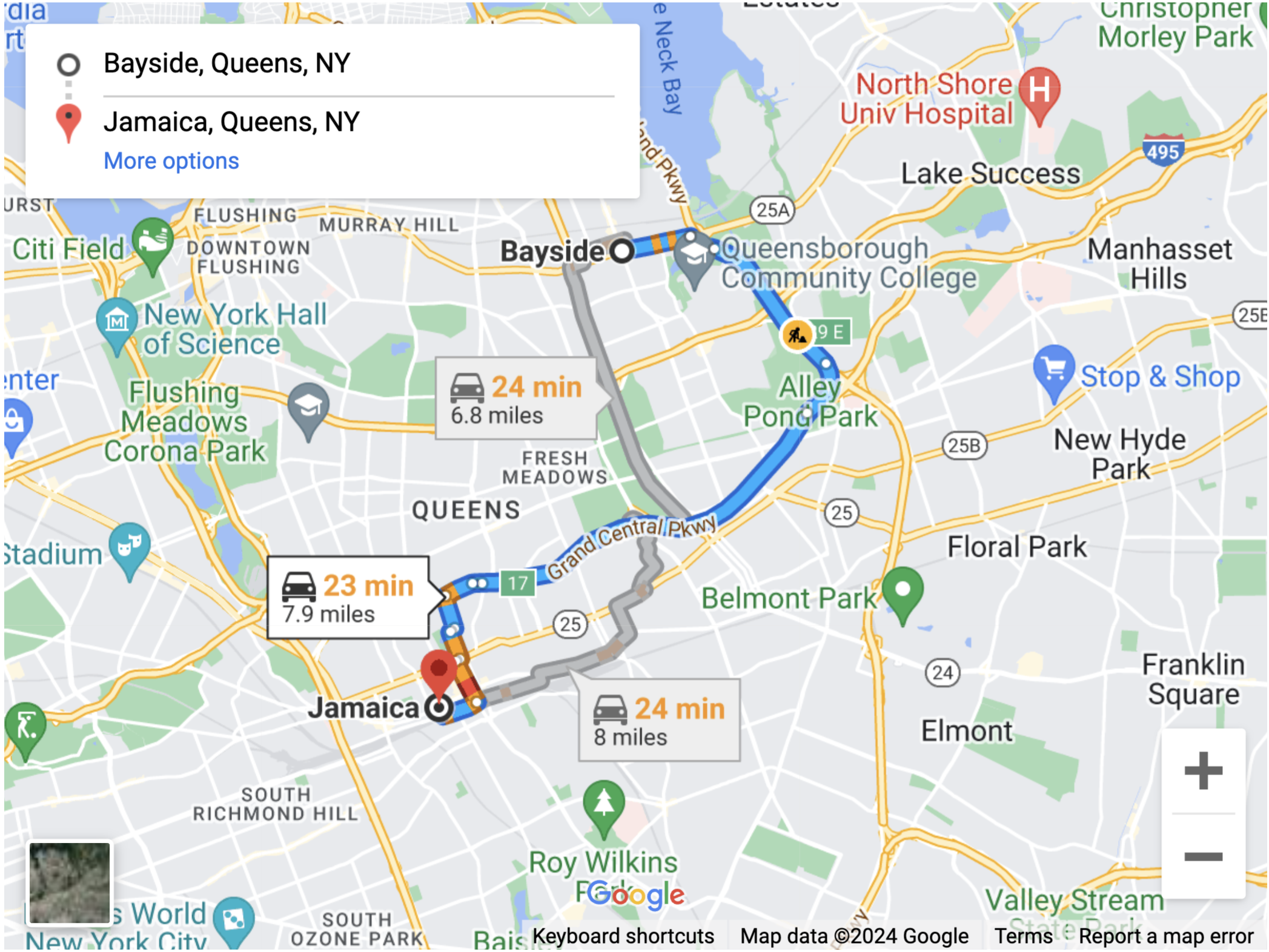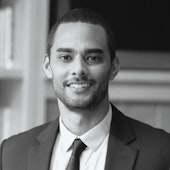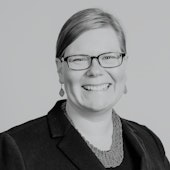Policymakers in New York are grappling with how to improve housing affordability statewide and in individual cities and towns. A critical path for doing so is reducing the exclusionary zoning barriers that artificially constrain the supply of housing, thereby driving up prices. As public officials shape those reforms to promote housing affordability, they have an equally important chance to improve educational opportunities for students by reducing economic and racial segregation in neighborhoods as well as in schools—both of which currently function as drivers of educational inequality.
National research has long suggested that government exclusionary housing policies—such as those that forbid the construction of multifamily housing and impose minimum lot size requirements—cause housing to be both more expensive and segregated.1 Over the past year, The Century Foundation (TCF) has produced a series of ten reports to underline the connection between education and housing in New York State. This report ties together those research projects so that policymakers, journalists, activists, and interested members of the general public can consider the evidence in one place.
The first part of this report highlights key findings from four TCF case studies of the ways in which exclusionary zoning creates unequal educational opportunities in different regions within New York State. Working closely with New York University’s Furman Center, TCF examined the connection between housing and educational opportunity in Westchester County, Long Island, Queens, and the Buffalo area. The second part highlights two important policies that could reduce exclusionary government practices: Governor Kathy Hochul’s Housing Compact and a proposal for a New York State Economic Fair Housing Act. The third part addresses the challenging politics of reform and highlights successful efforts to reduce restrictive housing policies from TCF case studies of California, Oregon, Minneapolis (Minnesota), and Charlotte (North Carolina). The fourth part highlights important messaging research conducted by TCF in partnership with Karp Strategies about the types of appeals that can work specifically in New York. The fifth part concludes.
|
HOW EXCLUSIONARY ZONING CREATES UNEQUAL EDUCATIONAL OPPORTUNITIES IN NEW YORK STATE
(Read the reports below:) |
|
Case Studies of Exclusionary Zoning and Unequal Educational Opportunity across New York State
1. Westchester County: Scarsdale and Port Chester
2. Long Island: Flower Hill and the Village of Hempstead
3. Queens: Bayside/Little Neck and Jamaica/Hollis
4. The Buffalo Region: East Aurora and Martin Luther King Park Neighborhood of Buffalo
|
|
Case Studies of Successful Reform from Across the Country
1. California
2. Oregon
3. Minneapolis
4. Charlotte
|
|
Messaging Research
1. When People Think of Housing, They Think Schools—and Vice Versa
2. 5 Tips for Talking about Exclusionary Zoning
|
The Challenge: How Exclusionary Zoning Inhibits Educational Opportunities
When people consider why some communities are mostly wealthy and others mostly poor, they may think that the free market in housing explains disparities. Communities with high-performing public schools and other amenities do typically command higher housing prices. But research suggests exclusionary government zoning laws that outlaw the construction of multifamily housing help explain a big part of the demographic divide between different communities in America. An important 2010 study of fifty metropolitan areas found that “a change in permitted zoning from the most restrictive to the least would close 50 percent of the observed gap between the most unequal metropolitan area and the least, in terms of neighborhood inequality.”2
Inequalities in neighborhoods translate into inequalities in schooling opportunities. All students deserve a rich education that prepares them to succeed in college and beyond, and diversity is a key component of that high-quality education. When students attend school with peers who come from different economic, racial, and cultural backgrounds, they develop stronger critical thinking and communications skills, creativity, and empathy—skills that colleges and employers increasingly seek. But when segregated neighborhoods result in segregated schools, students of all walks of life miss out on these benefits.3 And importantly, students in lower-income schools and neighborhoods, who are disproportionately Black and Hispanic, rarely get the full resources and opportunities they deserve. School districts with high concentrations of students living in poverty are more than twice as likely as other school districts to be underfunded,4 and low-income students attending predominantly low-income schools have worse educational outcomes than other low-income peers at more economically mixed schools.5 We see in practice what the court famously ruled in Brown v. Board: separate is inherently unequal.
To examine this issue more closely, TCF, working in partnership with Vicki Been, Hayley Raetz, Jiaqi Dong, and Matthew Murphy of NYU’s Furman Center, examined different New York communities located fairly close to one another geographically, and how the zoning laws kept working-class families out of high performing schools. The patterns are clear across New York regions: more restrictive zoning keeps low-income and working-class students, many of whom are students of color, out of high-performing schools.
Westchester County: Scarsdale and Port Chester
Read the full report, “How Zoning Drives Educational Inequality: The Case of Westchester County.”
In Westchester County, New York, two suburban communities—Scarsdale and Port Chester—are located just eight miles from one another away but they are remarkably distinct when it comes to their zoning laws, the demographic makeup of the residents, and the performance of the public schools. (See Figure 1.)
Figure 1

Scarsdale’s median household income, in excess of $250,000, is nearly three times that of Port Chester’s, as is the portion of residents with a college degree.6 And while three-quarters of Port Chester’s elementary students qualify for free or reduced-price meals at school, 0 percent of Scarsdale’s students do. Most of Scarsdale’s population (87 percent) is either white or Asian, while a large portion of Port Chester’s population (69 percent) is either Hispanic or Black. Many of Port Chester’s residents, the New York Times has noted, service “the affluent suburbs as landscapers, day laborers, house cleaners and children-care providers.”7
While the free market in housing has something to do with these differences, government zoning laws help drive the divide. In the vast majority of Scarsdale’s land, it is illegal to build anything but a single family home. Just 0.2 percent of Scarsdale’s housing lots are made up of structures classified as two- or three-family homes or apartments. Port Chester, by contrast, allows multifamily housing on about half its land.
Between 2014 and 2021, 41 percent (24 of 58) of units in Port Chester authorized to be built were for multifamily housing. In Scarsdale, none (0 of 218 units) were for multifamily homes. Although real estate developers typically make more money building multifamily housing rather than single-family homes in wealthy areas, Scarsdale essentially forbids it.
The schools in Scarsdale—which are off limits to many people of modest means because of zoning laws—offer several advantages to children. Scarsdale, for example, spends $5,500 more per pupil than Port Chester, and thus has lower student-to-teacher ratios—both of which are markers of improved academic outcomes. Likewise, in Scarsdale fewer than 1 percent of teachers are inexperienced (in their first or second year of teaching), compared with 18 percent of Port Chester teachers.
In 2019, 32 percent of Port Chester students were performing at grade level in English, compared with 87 percent of students in Scarsdale—a staggering 55-percentage-point gap. In math, 35 percent of Port Chester students performed at grade level, compared with 90 percent of Scarsdale students, also a 55-point gap.
Long Island: Flower Hill and the Village of Hempstead
Read the full report, “Housing and Educational Inequality: The Case of Long Island.”
In Nassau County on Long Island, the suburban communities of Flower Hill and the Village of Hempstead are nine miles apart, but a world away from one another in terms of zoning laws, community demographics, and public school performance. (See Figure 2.)
Figure 2

Flower Hill, a small community of 4,794 residents, had a population that is 74.4 percent non-Hispanic white, 12.3 percent Asian, 8.3 percent Hispanic, and just 1.7 percent Black in 2021.8 Eighty percent of the adult population had a bachelor’s degree or more. The median household income was a staggering $246,533. By contrast, the nearby Village of Hempstead, a community with 59,169 residents, had a population that is 46.3 percent Black, 45.1 percent Hispanic, and just 4.8 percent non-Hispanic white and 1.7 percent Asian in 2021. Just 17 percent of adults had a bachelor’s degree or more—a gaping 63-point gap in college attainment compared with Flower Hill. The median household income in Hempstead was $74,680, less than one third the income in Flower Hill. In Flower Hill–serving schools, 14.1 percent of students were eligible for free or reduced price lunch in 2021 at the elementary school level. In Hempstead, 65.1 percent of public school students are eligible for subsidized lunch.
Zoning regimes differ dramatically between the two jurisdiction. In Flower Hill, as Vicki Been of the NYU Furman center noted, multifamily housing is essentially banned, and as a result, “its housing stock is all single family homes.” In Flower Hill, 74.8 percent of the lot area in 2021 was occupied by existing structures classified as single-family, year-round residences, and most of the rest of the land was occupied by a country club and a hospital. Multifamily housing is banned throughout, unless the Village Board of Trustees makes an exception. A paltry 0.4 percent of the lot area consisted of two- or three-family housing or apartment buildings in 2021. The Village of Hempstead, by contrast, Been notes, has “a fairly dense, mixed-use land use system” that allows multifamily homes in much of the village’s land. A little more than half (55.1 percent) of lot area in 2021 was occupied by single-family, year-round residences. Been concludes, “Hempstead’s system has produced a higher-density community with a variety of housing choices for both renters and homeowners and different levels of income.”
Recent development in the two areas underline the distinction. In Hempstead, 33 percent of units (16 of 49) authorized to be built between 2014 and 2021 were for multifamily housing. In Flower Hill, the comparable figure was 0 percent (0 of 85 units). Every single unit authorized in Flower Hill was for a single-family home.
Educational opportunities and resources differ dramatically between the two communities. Researchers have concluded that in order to provide equal opportunity, schools with higher concentrations of poverty like those in the Village of Hempstead should spend more money per pupil in order to provide genuine equal opportunity. In fact, however, the per-pupil expenditure in 2020 was $16,443 in Hempstead, or about $4,000 less per pupil than in Flower Hill, where the expenditure was $20,457. That extra money in Flower Hill was able to purchase important educational benefits, such as lower student–teacher ratios. In 2021, for example, there were 9.6 students for every teacher in Flower Hill at the elementary school level, compared with 17.6 students for every teacher in Hempstead.
Teacher experience can improve academic achievement for children, yet in Hempstead, 15.2 percent of teachers were in their first or second year of teaching in 2017, six times the rate of Flower Hill, where just 2.5 percent of teachers were in their first or second year. Finally, access to College Board Advanced Placement (AP) classes can be a sign of a rich and rigorous curriculum. At Flower Hill, those courses are abundant. Roslyn High School offers twenty-four types of AP classes, and Paul D. Schrieber Senior High School offers thirty-seven types of AP classes. Local data suggest that Hempstead High School offered seventeen AP courses
In 2019, 31 percent of Hempstead students were performing at grade level in English, compared with 74 percent of students in Flower Hill—a staggering 43-percentage-point gap. In math, 31 percent of Hempstead students performed at grade level, compared with 77 percent of Flower Hills students, an even larger 46-point gap. In 2021, only 75 percent of Hempstead public high school students graduated in four years, compared with 95 percent of Flower Hill public high school students.
Queens: Bayside/Little Neck and Jamaica/Hollis
Read the full report, “How Housing Policies Create Unequal Educational Opportunities: The Case of Queens, New York.”
In the New York City borough of Queens, the suburban communities of Bayside/Little Neck and Jamaica/Hollis are located just seven miles apart—a twenty-minute drive—and yet they are enormously different when it comes to their land use laws and the demographic makeup of the residents and educational opportunities. (See Map 3.)
Figure 3

The demographics of these neighboring communities are starkly different. Jamaica/Hollis is 71 percent Black and Hispanic, while Bayside/Little Neck is 81 percent Asian and white.9 Bayside/Little Neck residents aged 25 and older are more than twice as likely to hold a bachelor’s degree or more (47 percent) as residents of Jamaica/Hollis (23 percent). In Bayside/Little Neck, median household income is 26 percent higher, and median home sale prices for single-family homes are 57 percent higher than in Jamaica/Hollis. Meanwhile, poverty rates, unemployment rates, and the share of residents who are renters are all higher in Jamaica/Hollis than Bayside/Little Neck. In the schools, more than three quarters (76 percent) of students in Jamaica/Hollis elementary schools are eligible for free or reduced price lunch compared with less than half (47 percent) of students in Bayside/Little Neck.
How did these communities become so different? Part of the reason is that in Bayside/Little Neck, zoning laws are substantially more restrictive than in Jamaica/Hollis. Anything more than a single-family detached home is banned on a majority (57 percent) of Bayside/Little Neck’s residential lots, compared with just 12 percent of lots in Jamaica/Hollis. Larger multifamily dwellings are much harder to build in Bayside/Little Neck. Although the two communities are roughly comparable in size geographically, in 2021, just fifty-four units were authorized by new building permits in properties with more than ten units in Bayside/Little Neck, compared with twenty-one times as many units (1,158) in such buildings in Jamaica/Hollis.
Schooling opportunities differ in the two communities. In Jamaica/Hollis, for example, teachers are more likely to be inexperienced and new to the profession than in Bayside/Little Neck. More than 10 percent of teachers in Jamaica/Hollis are in their first or second year of teaching, compared with 6 percent of teachers in Bayside/Little Neck.
Academic performance in the two sets of jurisdictions is also starkly different. The most reliable testing data come from 2019, before the COVID-19 pandemic upended participation in standardized testing in New York City public schools. In that year, more than three-quarters of fourth graders in Bayside/Little Neck were proficient or performing at grade level in English, compared with less than half in Jamaica/Hollis. In math, the fourth grade results were even more dramatically different: 83 percent of Bayside/Little Neck students tested proficient in math compared with just 37 percent of students in Jamaica/Hollis, a staggering 46-point gap. In addition, Bayside/Little Neck students had a four-year high school graduation rate that was 18 points higher than in Jamaica/Hollis.
The Buffalo Region: East Aurora and Martin Luther King Park Neighborhood of Buffalo
Read the full report, “How Zoning Promotes Inequality in Education: The Case of the Buffalo Area.”
Finally, in the Buffalo region, the suburban community of East Aurora, New York stands in sharp contrast to the Martin Luther King Park section of Buffalo, even though they are located in the same metropolitan region. As in the other case studies, the zoning laws, demographics and school performance of the two communities look a world apart—despite the fact that they are just twenty-two miles from one another. (See Map 4.)
Figure 4

East Aurora, a village of 5,998 residents, had a population that was 94.9 percent non-Hispanic white, 1.9 percent Hispanic, 0.7 percent Black, and 0.5 percent Asian in 2021.10 Some 53.5 percent of residents had a bachelor’s degree or more. The median household income was $88,286. The community of Martin Luther King Park, within the city of Buffalo, is much poorer and more racially diverse. In 2021 it had 4,685 residents, of whom 70.4 percent were Black, 12.5 percent Hispanic, 12.2 percent Asian, and 1.5 percent non-Hispanic white. Just 17.4 percent of adults had a bachelor’s degree or more. The median household income in Martin Luther King Park was $24,643, less than one-third of the income in East Aurora. Martin Luther King Park is located in Buffalo’s East Side, about a mile from the site of the May 2022 tragic shooting at the Topps grocery store by a self-proclaimed white supremacist. In East Aurora, just 12.3 percent of students were reported as eligible for free or reduced price lunch in 2021 at the elementary school level. In the Martin Luther King Park neighborhood, by contrast, 88.2 percent of public school students were eligible for subsidized lunch.
The two communities did not end up with such different populations by accident. East Aurora and Martin Luther King Park offer a stark contrast in how communities choose to zone, and what sort of housing they allow to be built. In East Aurora, the vast majority of the land is set aside for single-family residential living. As Vicki Been notes, these single family areas are further limited to “detached homes on lots of at least 10,500 square feet.” In 2021, just 3.5 percent of East Aurora’s lot area was made up of existing structures classified as two- or three-family homes or apartments. By contrast, the city of Buffalo has taken a much more inclusive approach to zoning on the whole. According to Been, in 2017, Buffalo enacted a widely heralded “greencode” zoning ordinance, which won a national award from the Congress for New Urbanism. Most of the areas of Martin Luther King Park are coded N3-R “Urban Neighborhood Residential,” which Been notes “allows detached and attached dwellings as well as three story multifamily apartment buildings.” Been points out much of the neighborhood “allows detached and attached dwellings as well as three story multifamily apartment buildings.” In 2021, nearly one-quarter (22.9 percent) of lot area was classified as two- or three-family lots or apartments—more than six times the share found in East Aurora.
Recent housing growth in East Aurora and Martin Luther King Park vividly illustrate their starkly different zoning regimes. In East Aurora, 100 percent of units (17 out of 17 units) authorized to be built between 2014 and 2021 were for single-family housing units. In Martin Luther King Park, by contrast, only 2 percent of new units (1 out of 51 units) were for single-family homes.
While schools with higher concentrations of poverty such as those in Martin Luther King Park need substantially more money per pupil to provide genuine equal opportunity, Martin Luther King Park area public school expenditures in 2020 were $14,629 per pupil, or $2,854 more than the $11,775 spent in East Aurora, which amounts to a 24 percent premium. Researchers estimate that, to equalize opportunity, high-poverty schools such as those found in Martin Luther King Park should be spending some 78 percent more.
Teacher experience can improve academic achievement for children, yet in Martin Luther King Park, 20.6 percent of teachers were in their first or second year of teaching in 2017, compared with 13.3 percent of teachers in their first or second year in East Aurora. At East Aurora High School, seventeen Advanced Placement courses are offered, compared with fewer than three AP classes at East Community High School in the Martin Luther King Park area.
Given the very different levels of opportunity provided, it is not surprising that performance levels in the two areas are dramatically different. In 2019, 16 percent of Martin Luther King Park students were performing at grade level in English, compared with almost three times that success rate (45 percent of students) in East Aurora. In math, 13 percent of students performed at grade level in Martin Luther King Park, compared with a success rate four times higher (55 percent) among East Aurora students. Most troubling of all, in 2021, Martin Luther King Park students were less than half as likely to graduate from high school in four years (42 percent) as those in East Aurora (98 percent).
What Is to Be Done?
What can be done to reduce the exclusionary barriers that some communities erect that reduce educational opportunities in different regions in New York State, and drive up housing prices by artificially restricting supply? TCF’s series of reports homed in on two critical proposals: support for Governor Kathy Hochul’s Housing Compact (or some revised version of it), and adoption of a New York State Economic Fair Housing Act.
Hochul Housing Compact
In January 2023, Governor Kathy Hochul sought to address the state’s housing affordability crisis by proposing the New York Housing Compact to build 800,000 new homes over the next decade. Under the compact, municipalities would have been given the goal of increasing their housing supply by 3 percent every three years (if they were located downstate) and by 1 percent every three years (if they were located upstate). If communities failed to reach their goals, the state would require municipalities to provide applicants for housing permits with a fast-track approval process. In addition, downstate areas would need to rezone for greater housing within a half mile of commuter railway and subway stations.11
Governor Hochul’s housing plan was slated to be “the most consequential” reform in decades, a “potential centerpiece for her first term,” the New York Times reported. But in a “spectacular failure,” a Democratically controlled legislature ended up killing the Democratic governor’s proposal, in large measure because of suburban opposition.12
The fundamental logic behind the plan—that New York needs more housing and exclusionary zoning policies are a huge impediment—is fundamentally sound, so it would be advisable for the state legislature to reconsider either the original Hochul plan or a revised version that advances the principles found in the original idea.
New York State Economic Fair Housing Act
Given the political failure of the Housing Compact—and strong opposition from some suburban Democrats in places such as Westchester County—it also makes sense to consider new strategies that do not rely on Democratic votes alone. What sort of zoning reform policy might facilitate a cross-racial bipartisan coalition (that could also include some upper-middle class white liberals of good will)?
Earlier TCF reports have outlined the idea of a state-level Economic Fair Housing Act, that could galvanize working-class voters of all races, both Democratic and Republican. As outlined below in Section III, these types of coalitions have come together around housing in California, Oregon and elsewhere.
Members of Congress have discussed the idea of creating a federal Economic Fair Housing Act, under which communities that discriminate by income through their zoning laws would, if challenged, have to provide a powerful justification that such laws are “necessary.” If they failed to do so, federal judges could impose injunctive relief to eliminate the economic discrimination. A municipality that banned multifamily housing in much of its community, for example, could come under close judicial scrutiny under the law.13
New York State could take the lead in creating the nation’s first state-level Economic Fair Housing Act. In the realm of civil rights laws, state governments have often enacted their own anti-discriminatory laws in advance of federal action. For example, several states—including New York—have enacted protections against “source-of-income” discrimination (typically, to shield Section 8 Housing Choice Voucher recipients from discrimination by landlords who refused to take vouchers).14 A New York State Economic Fair Housing Act could make clear that just as source-of-income discrimination is wrong, so is income discrimination by government zoning laws.
The Politics of Reform: Case Studies of Success
Given the challenging politics of reforming zoning laws, The Century Foundation published a series of four case studies of successful efforts to enact reform. These examples of success come from different parts of the country—from California and Oregon to Minneapolis and Charlotte. Below are highlights from those reports.
California
Read the full report, “Building a Multiracial, Cross-Party Populist Coalition for Zoning Reform: What New York Can Learn from California.”
In 2021, California faced the same dilemma that New York is currently facing. Housing prices had become intolerable in the state, yet the state legislature’s efforts to reform zoning had largely come up short in 2018, 2019, and 2020 because of staunch opposition from localities.15 But after several failed attempts, in August 2021, the state legislature passed SB 9, which legalized duplexes statewide and allowed people to subdivide lots, which could translate into as many as four homes on what had previously been zoned a single-family lot. The law “has opened up entire communities that had been largely walled off,” said Ben Metcalf of the University of California at Berkeley’s Turner Center.16
The legislation passed because supporters of reform recognized that they needed to create a different type of political coalition than typically is employed to pass liberal legislation. As in New York, pro-housing forces in California could not rely on ideological or party loyalty. Research found that within California cities, some of the most liberal areas had the worst forms of exclusionary zoning.17 Instead, crucial votes of support in the state assembly came from an unusual multi-racial cross-party coalition that included urban Democrats and seven Republicans, mostly representing rural areas, who provided the margin of victory.18
Two populist threads united the cross-racial working-class coalition. The first was frustration with housing costs. The flip side of existing NIMBY homeowners wanting very high returns on their investment is that it makes housing unaffordable for everyone else. Homelessness in California had increased 40 percent.19 And even upper-middle-class millennials who had gone to college couldn’t afford rent. Census figures showed that one-third of California’s renters paid more than half their monthly income for rent.20 The Milpitas, California school district sent a note to parents asking them if they would allow teachers to move in with them and rent a room because affordability was such a problem.21
The second bipartisan populist thread centered around opposition to exclusion from opportunity. Exclusionary zoning is essential to perpetuating a separate ecosystem for the privileged that many on the outside recognize as unfair. Under this system, author George Packer points out, an elite class of salaried professionals “go to college with one another, intermarry, gravitate to desirable neighborhoods in large metropolitan areas, and do all they can to pass on their advantages to their children.”22
Oregon
Read the full report, “A Bipartisan Vision for the Benefits of Middle Housing: The Case of Oregon.”
In 2019, Oregon became the first state in the nation to legalize duplexes, triplexes, and fourplexes—commonly known as middle housing—statewide. House Bill 2001 (HB 2001, also often referred to as the housing choices bill or the missing middle housing bill) passed the state legislature on June 30, 2019, with bipartisan majorities in both the state senate and house, and was signed into law that August.
The path to this legislation, which was groundbreaking on multiple fronts, was forged in response to a severe housing crisis. From 2010 to 2020, Oregon’s population grew by 400,000 people, the number of homes only increased by 150,000, and average housing prices doubled.23 This housing crisis was also a racial justice issue: Oregonians of color are significantly more likely than White Oregonians to be renting their home, and have lower incomes on average, resulting in a greater likelihood of being “cost-burdened” by housing.24
This crisis lit a fire for reform. When Democratic representative Tina Kotek became speaker of the Oregon House of Representatives in 2013, she began making housing a priority. But no state had passed legislation like this before, so there was no playbook to follow. Kotek’s first attempt to legalize middle housing in 2017 failed, but the process helped to organize supporters, identify opponents, and locate potential dealbreakers.25 Advocates and legislators in Oregon learned from these efforts in order to craft a winning strategy in 2019.
The legislation passed thanks in large part to intentional bipartisan coalition building. Oregon’s “missing middle” legislation was bipartisan, from the shaping of the bill to the final vote. Supporters and opponents came from both parties, and although the legislation was led by Democrats, it would not have passed without Republican support. The coalition for housing reform in Oregon also addressed concerns from various progressive groups ahead of time to ensure a unified front on the left, making it harder for Democrats to oppose the bill.
Notably, one of the supporters of the legislation was Portland Public Schools. In her testimony on behalf of the school district, Courtney Westling, former director of government relations for Portland Public Schools, highlighted several ways that building missing middle housing could benefit the educational futures of Portland’s students. Building more housing would help address homelessness. Zoning changes would also increase opportunities for more affordable housing within walking distance of schools. And it had the potential to fight against segregation: “Exclusionary zoning leads to economic segregation of schools—and—as a result, racial segregation. Why is the student population of one PPS school 14 percent white while another three miles away is 79 percent white? One reason is exclusionary single-family zoning.”26
Minneapolis
Read the full report,“Rallying the Voices of the Excluded for Zoning Reform: The Case of Minneapolis.”
Back in 2017, Minneapolis employed widespread exclusionary zoning. On 70 percent of the city’s residential land, it was illegal to build anything but a detached single-family home.27 But then, in 2018, observers were stunned when the Minneapolis City Council voted to do something long considered impossible in American politics: it became the first major city in America to end single-family exclusive zoning citywide.28
Backers of reform stressed a trio of goals: reducing exclusionary zoning would increase affordability, promote racial justice, and be good for the environment. First, advocates noted that studies found that housing supply wasn’t keeping up with growth. The Metropolitan Council suggested that the city had built only 64,000 new homes since 2010 while adding 83,000 households.29 “When you have demand that is sky-high, and you don’t have the supply to keep up with it, prices rise. Rents rise,” noted Mayor Jacob Frey.30 Second, advocates of the change argued that exclusionary single-family zoning should end because it fosters economic and racial segregation, which harms the community. Reformers explicitly pointed out the connection between local zoning and redlining. “Today’s zoning is built on those old redlining maps,” said the city’s long-range planning director Heather Worthington.31 Advocates of zoning reform like Kyrra Rankine argued: “Zoning is the new redlining.”32 Third, reformers pointed out that eliminating single-family exclusive zoning and build more housing near transit stops would be good for the environment. Dense housing usually means more walkability and access to public transportation. And density also reduces the carbon footprint of housing because housing units that are closer together have lower heating and cooling costs.33 This argument had special resonance with young people.
These types of arguments hit home, but what really set Minneapolis’s effort apart was the inclusion of voices of those who are often not present in zoning debates. Activists knew that wealthy white homeowners were going to make their voices heard.34 It was critical that lower-income communities, immigrant communities, and communities of color have a seat at the table too. And so, said local activist Janne Flisrand, “The city made a point of creating an engagement pathway” for marginalized communities.35 Indeed, if there was a secret ingredient in Minneapolis’s success, it was community engagement, Flisrand says.36 The city engaged in a multiyear effort to gain input.37 The city’s Long Range Planning Team within the Community Planning and Economic Development Department recognized explicitly that, “historically, people of color and indigenous communities (POCI), renters, and people from low-income backgrounds have been underrepresented in the civic process.”38 Going back to 2016, planners attended festivals and street fairs and went to churches to gather input. The city also encouraged residents to hold “Meetings in a Box,” whereby individuals were provided forms and surveys to seek input from community members at a time and place that were convenient.39 They didn’t speak in jargon-laden terms about “increasing housing density,” but instead asked big questions such as, “Are you satisfied with the housing options available to you right now?” and “What does your ideal Minneapolis look like in 2040?”40
Charlotte
Read the full report, “Fair Housing Reform in a Southern City: The Case of Charlotte.”
Charlotte, North Carolina is a growing Southern city with population growth that is outpacing its increase in housing stock.41 Charlotte city government predicts that the city’s population will increase by 385,000 over the next two decades.42
Prior to 2021, there was no real plan to tackle the existing and constantly worsening housing shortage in the Queen City. Yet in August of that year, city leaders came together to pass a comprehensive housing reform framework known as the Charlotte Future 2040 Comprehensive Plan (“the 2040 Plan”). The 2040 Plan’s adoption was not without debate and pushback; nonetheless, a coalition of advocates was able to win over some key constituencies that were initially dubious that the merits of the plan outweighed its drawbacks.
The most hotly contested provision of the 2040 Plan was the goal to permit multifamily housing, by right, in parts of the city that previously only permitted single-family housing. Advocates argued that permitting duplexes, triplexes, and in some cases, fourplexes, would both increase the available housing stock as well as open opportunities for residents who had been historically shut out of high opportunity neighborhoods to live in them.
Detractors of the 2040 Plan argued that allowing multifamily housing in neighborhoods that historically only permitted single-family housing would degrade the “character” of these places and thereby threaten to reduce property values. There were also some Charlotteans who worried that the new plan would spur gentrification and displacement. And initially, even the developer community was skeptical of the plan because of certain provisions that they believed would make it more expensive to do business.
As the 2040 Plan worked its way through the city council, advocates on city council and other city leaders such as planner Taiwo Jaiyeoba and Mayor Vi Lyles were able to make changes to satisfy key constituencies. First, they added in a provision that recommended the formation of an “anti-displacement commission” to specifically “recommend tools and strategies for protecting residents of moderate to high vulnerability of displacement,” gaining some support among community members and council members who wanted to ensure specific protection against displacement. Second, they stripped out enough specific building requirements that developers found onerous to win over support of the main local developer’s association.43
While insiders and policy makers went back and forth over the minutiae, the community was having the debate at a much higher altitude—for many Charlotteans, the very notion of Charlotte as a place where the American Dream was possible was at stake. Some residents saw the American Dream through the lens of the single-family home that they were able to work toward, and worried that the 2040 Plan would make that version of the dream harder for their children to attain. Conversely, other Charlotteans believed that the city had not lived up to its ideals historically, and that the 2040 Plan would begin to address the legacies of redlining and segregation in a meaningful way. Not far from the debates were the implications for schooling and educational opportunity. As the Charlotte–Mecklenburg school system was redrawing certain district lines, the debates about opportunity and segregation played out there, too.
Ultimately, supporters of reform won out when the city council adopted the 2040 Plan by a 6–5 vote. Advocates were able to gain victory, not only by convincing key constituencies about the merits of the plan, but also by leading with common sense and easy-to-understand messages about what they were trying to achieve. More inclusive zoning leads to more housing. More housing results in greater affordability. These concepts make sense, are easy to digest, and resonate with the harsh reality of how expensive urban life is all across America.
And finally, the 2040 Plan’s passage reaffirmed the feeling that Charlotteans wanted to have about their city as a place that prided itself on being a city of opportunity, a community that prided itself on its diversity, and one that desperately wanted to overcome its historical legacy of segregation.
Messaging Research Tailored to New York State
Read the full reports, “5 Tips for Talking about Exclusionary Zoning” and “When People Think of Housing, They Think Schools—and Vice Versa.”
Data and evidence alone are not enough to win the policy fight for better housing policies to support more inclusive communities, in New York and beyond. Messaging and effective communication is also key. To that end, TCF partnered with Karp Strategies, an urban planning strategy and consulting firm, to conduct research on how the public responds to language around zoning, zoning reform, housing equity, and its impact on K–12 education, and what messaging would be successful in persuading decisionmakers and voters to reform damaging and exclusionary zoning practices. The research included roughly a dozen interviews with stakeholders and over 150 survey responses from New Yorkers across four different geographic regions (Queens, Long Island, Westchester, and Buffalo).
Here are several key takeaways from that research:
Fears about overcrowding schools fuel opposition to reforming housing policies. Flip the story to embrace growth. In the interviews and survey data, there was a widespread belief that allowing different types of multi-family homes would lead to an increase in families and overcrowding in schools. These fears were also tied up with bias and stereotypes about class, race, and immigration status, with many people assuming that new students would have a negative effect on the local public schools. Untangling these views and biases can be tricky, but to begin with, evidence shows that, in many cases, schools are not actually overcrowded. It helps to shift the narrative to focus on the benefits of growth for creating thriving schools, to paint a picture of a school system that with growing student populations sees expanded resources and increased learning opportunities.
Emphasizing the benefits to students and families is more convincing than a social justice–centered argument. TCF’s research on exclusionary zoning and educational opportunity is rooted in a social justice argument that all students deserve a quality education and that current housing policies are unfairly excluding low-income students and students of color from some of the highest-opportunity schools. While the research showed this was a motivating factor for housing reform advocates and some community leaders, it was not as effective messaging when talking with the general public about this issue. People were more open to new housing policies when they were informed how these changes might positively affect their own lives.
Use positive framing. Most policymakers and journalists talk about housing reform in terms of getting rid of harmful zoning laws. TCF research found that it was much more effective to frame the issue positively and talk about what types of housing will be allowed by changing zoning laws. For example, instead of focusing on “banning single-family zoning,” emphasize legalizing different types of multi-family homes—such as duplexes, garden apartments, and small apartment buildings.
Above all, housing reform advocates should aim to reassure people who may be fearful that, despite at times legitimate concerns about school overcrowding or the aesthetics of a neighborhood changing, allowing more housing into a community benefits everyone. Emphasize that when done carefully and with community members involved in the process, zoning reform can bring greater affordability to the neighborhood as a whole, more resources to the school system and community spaces, and prepare future generations for a world that is increasingly diverse.
Conclusion
The high cost of housing in New York is taking its toll: as of December 2023, New York State is losing more residents per year than any other state in the country.44 It is enormously important that New York State reduce the exclusionary zoning barriers that make housing unaffordable and segregate neighborhoods and schools. The body of evidence assembled in this report—and in the ten previously published reports that were part of this project—suggests that reform is both highly desirable and also possible. People living in places as diverse as Westchester County, Long Island, Queens, and the Buffalo region are hurt by the laws that artificially drive up home prices and reduce educational opportunities for children of low-wage families. At the same time, experience in California, Oregon, Minneapolis, and Charlotte suggest that it is possible to enact changes that will enhance the lives of residents. Using some of the messaging findings specifically geared toward New York could help bring about a better life for all New Yorkers. Reforming exclusionary housing policies will not only make housing more affordable in the near future—an important and worthy goal—it will pay dividends for years to come by improving the educational opportunities of New York’s children.
Notes
- See, e.g., Richard D. Kahlenberg, Excluded: How Snob Zoning, NIMBYism and Class Bias Build the Walls We Don’t See (New York: Public Affairs Books, 2023).
- Jonathan Rothwell and Douglas Massey, “Density Zoning and Class Segregation in U.S. Metropolitan Areas,” Social Science Quarterly 91, no. 5 (December 2010): 1123–43, http://www.ncbi.nlm.nih.gov/pmc/articles/PMC3632084/.
- “The Benefits of Socioeconomically and Racially Integrated Schools and Classrooms,” The Century Foundation, April 29, 2019, https://tcf.org/content/facts/the-benefits-of-socioeconomically-and-racially-integrated-schools-and-classrooms/.
- “Closing America’s Education Funding Gaps,” The Century Foundation, July 22, 2020, https://tcf.org/content/report/closing-americas-education-funding/.
- Heather Schwartz, “Housing Policy Is School Policy: Economically Integrative Housing Promotes Academic Success in Montgomery County, Maryland,” The Century Foundation, 2010, https://tcf.org/content/report/housing-policy-school-policy-economically-integrative-housing-promotes-academic-success-montgomery-county-maryland/.
- Unless otherwise noted, the sources for data and quotations presented in this section can be found in the report being discussed.
- Lisa Prevost, “Port Chester, N.Y.: A ‘Tiny Little Village’ With a Lot of Development,” New York Times, March 1, 2023, https://www.nytimes.com/2023/03/01/realestate/port-chester-ny-housing.html.
- Unless otherwise noted, the sources for data and quotations presented in this section can be found in the report being discussed.
- Unless otherwise noted, the sources for data and quotations presented in this section can be found in the report being discussed.
- Unless otherwise noted, the sources for data and quotations presented in this section can be found in the report being discussed.
- Governor Kathy Hochul, “Governor Hochul Announces Statewide Strategy to Address New York’s Housing Crisis and Build 800,000 New Homes,” January 10, 2023, https://www.governor.ny.gov/news/governor-hochul-announces-statewide-strategy-address-new-yorks-housing-crisis-and-build-800000; and Governor Kathy Hochul, “Remarks as Prepared: Governor Hochul Delivers 2023 State of the State,” January 10, 2023, https://www.governor.ny.gov/news/remarks-prepared-governor-hochul-delivers-2023-state-state.
- Luis Ferré-Sadurní and Mihir Zaveri, “New York Officials Failed to Address the Housing Crisis. Now What?” New York Times, April 27, 2023, https://www.nytimes.com/2023/04/27/nyregion/nyc-housing-crisis.html; Grace Ashford, “Gov. Hochul Gets a Budget Deal, but No Signature Win,” New York Times, April 28, 2023, https://www.nytimes.com/2023/04/28/nyregion/hochul-budget-ny.html; and Kahlenberg, Richard D. Kahlenberg, “How Zoning Drives Educational Inequality: The Case of Westchester County,” The Century Foundation, July 17, 2023, https://tcf.org/content/report/how-zoning-drives-educational-inequality-the-case-of-westchester-county/.
- See Jerusalem Demsas, “Could a 54-year-old civil rights law be revived? Decades after Martin Luther King Jr.’s fight, American cities still segregate communities by race and class,” Vox, January 17, 2022 (quoting Rep. Emmanuel Cleaver on the need for an Economic Fair Housing Act); Richard D. Kahlenberg, “An Economic Fair Housing Act,” The Century Foundation, August 3, 2017, https://tcf.org/content/report/economic-fair-housing-act/; Kahlenberg, Excluded,191–205; and Equitable Housing Institute, “Economic Fair Housing Act of 2021: Partial Draft Bill and Comments,” November 30, 2020, https://www.equitablehousing.org/images/PDFs/PDFs–2018-/EHI_Economic_FHA_of_2021_draft-rev_11-30-20.pdf.
- See Poverty and Race Research Action Council, “Expanding Choice: Practical Strategies for Building a Successful Housing Mobility Program—Appendix B: State, Local and Federal Laws Barring Source-of-Income Discrimination,” July 2023, http://www.prrac.org/pdf/AppendixB.pdf.
- Conor Dougherty, “After Years of Failure, California Lawmakers Pave the Way for More Housing,” New York Times, August 26, 2021, https://www.nytimes.com/2021/08/26/business/california-duplex-senate-bill-9.html.
- See Conor Dougherty, “Where the Suburbs End: A Single-Family Home from the 1950s Is Now a Rental Complex and a Vision of California’s Future,” New York Times, October 8, 2021, https://www.nytimes.com/2021/10/08/business/economy/california-housing.html.
- Mathew Kahn, “Do Liberal Cities Limit New Housing Development? Evidence from California,” Journal of Urban Economics, March 2011, https://www.sciencedirect.com/science/article/abs/pii/S0094119010000720.
- Michael Andersen, “Five Lessons from California’s Big Zoning Reform: A Pattern Is Emerging Here,” Sightline Institute, August 26, 2021, https://www.sightline.org/2021/08/26/four-lessons-from-californias-big-zoning-reform/.
- Dougherty, “After Years of Failure, California Lawmakers Pave the Way.”
- Conor Dougherty and Brad Plumer, “A Bold, Divisive Plan to Wean Californians from Cars,” New York Times, March 16, 2018, https://www.nytimes.com/2018/03/16/business/energy-environment/climate-density.html.
- Jonathan Edwards, “School District in Bay Area Asks Parents to Let Teachers Move In as Rent Soars,” Washington Post, September 2, 2022, https://www.washingtonpost.com/nation/2022/09/02/teacher-housing-california-bay-area/.
- George Packer, Last Best Hope: America in Crisis and Renewal (New York: Farrar, Straus & Giroux, 2021), 86.
- “Eliminating Single-Family Zoning and Parking Minimums in Oregon,” Bipartisan Policy Center, September 26, 2023, https://bipartisanpolicy.org/blog/eliminating-single-family-zoning-and-parking-minimums-in-oregon/.
- “One in Three Oregon Families Struggle to Afford Housing,” Oregon Center for Public Policy, March 15, 2018, https://www.ocpp.org/2018/03/15/20180315-cost-burdened-housing/.
- Michael Andersen, “Eight Ingredients for a State-Level Zoning Reform,” Sightline Institute, August 13, 2021, https://www.sightline.org/2021/08/13/eight-ingredients-for-a-state-level-zoning-reform/
- “Testimony supporting HB 2001,” Oregon State Legislature, Joint Committee on Ways and Means, Subcommittee on Transportation and Economic Development, June 11, 2019, https://olis.oregonlegislature.gov/liz/2019R1/Downloads/CommitteeMeetingDocument/203938.
- Emily Badger and Quoctrung Bui, “Cities Start to Question an American Ideal: A House with a Yard on Every Lot,” New York Times, June 18, 2019, https://www.nytimes.com/interactive/2019/06/18/upshot/cities-across-america-question-single-family-zoning.html.
- Portions of this case study draw from Richard D. Kahlenberg. Excluded: How Snob Zoning, NIMBYism and Class Bias Build the Walls We Don’t See (New York: Public Affairs Books, 2023).
- Sisson, “Can Minneapolis’s Radical Rezoning Be a National Model?”
- Christian Britschgi, “Progressive Minneapolis Just Passed One of the Most Deregulatory Housing Reforms in the Country,” Reason, December 10, 2018, https://reason.com/2018/12/10/progressive-minneapolis-just-passed-one.
- Sisson, “Can Minneapolis’s Radical Rezoning Be a National Model?”
- Quoted in Richard D. Kahlenberg, “Minneapolis Saw That NIMBYism Has Victims,” The Atlantic, October 24, 2019, https://www.theatlantic.com/ideas/archive/2019/10/how-minneapolis-defeated-nimbyism/600601/.
- Edward L. Glaeser, “Green Cities, Brown Suburbs: To Save the Planet, Build More Skyscrapers—Especially in California,” City Journal, Winter 2009, https://www.city-journal.org/html/green-cities-brown-suburbs-13143 .html.
- Einstein, Glick, and Palmer, Neighborhood Defenders, 103–105. See also Holder and Capps, “The Push for Denser Zoning Is Here to Stay.”
- Flisrand interview I. See also Casey Berkovitz, “Is a Better Community Meeting Possible?” The Century Foundation, August 20, 2019, https://tcf.org/content/commentary/better-community-meeting-possible/.
- Flisrand, “Minneapolis’ Secret 2040 Sauce Was Engagement.”
- Grabar, “Minneapolis Confronts Its History of Housing Segregation.”
- “Welcome to Minneapolis 2040,” 177, https://minneapolis2040.com/media/1488/pdf_minneapolis2040.pdf.
- Berkovitz, “Is a Better Community Meeting Possible?”
- Janne Flisrand, “Minneapolis’ Secret 2040 Sauce Was Engagement,” Streets MN, December 10, 2018, https://streets.mn/2018/12/10/minneapolis-secret-2040-sauce-was-engagement/; and Richard D. Kahlenberg, “How Minneapolis Ended Single-Family Zoning,” The Century Foundation, October 24, 2019, https://tcf.org/content/report/minneapolis-ended-single-family-zoning/.
- During the 2010–20 period, population increased by 21.6 percent, while housing unit increase lagged behind at 20.2 percent. Michael D. Tanner, “Keeping North Carolina’s Housing Affordable,” Policy Analysis no. 938, Cato Institute, December 7, 2022, https://www.cato.org/policy-analysis/keeping-north-carolinas-housing-affordable#introduction.
- “Introduction,” Charlotte Future 2040 Comprehensive Plan, City of Charlotte, https://www.cltfuture2040plan.com/plan-policy/introduction.
- “Goal 2: Neighborhood Diversity and Inclusion,” Charlotte Future 2040 Comprehensive Plan, City of Charlotte, June 1, 2021, https://www.cltfuture2040plan.com/content/goal-2-neighborhood-diversity-and-inclusion
- E. J. McMahon, “NY’s Population Loss Slowed a Bit in ‘23, but Loss Still Worst in U.S.,” Empire Center, December 19, 2023, https://www.empirecenter.org/publications/nys-post-pandemic-population-loss-slowed-a-bit-last-year-but-still-worst-in-u-s/.











